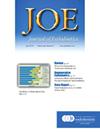Antibacterial Effects of Silica Nanoparticles Loading Nano-silver and Chlorhexidine in Root Canals Infected by Enterococcus faecalis
IF 3.5
2区 医学
Q1 DENTISTRY, ORAL SURGERY & MEDICINE
引用次数: 0
Abstract
Introduction
The persistence of microbial infection can lead to endodontic failure. Enterococcus faecalis (E. faecalis) is acknowledged to be a closely associated bacterium. This study investigated the antimicrobial effects of mesoporous silica nanoparticles (nMS) carrying nano-silver and chlorhexidine (nMS-nAg-Chx) on E. faecalis.
Methods
Analyses were conducted to assess the antimicrobial efficacy of nMS-nAg-Chx toward planktonic E. faecalis, including the zone of inhibition, minimal inhibitory concentration, and growth curves. The measurement of lactic acid, scanning electron microscopy, live-dead bacteria staining, and quantitative real-time PCR were done to further investigate its anti-biofilm effect. Colony forming unit and scanning electron microscopy were used to assess its efficacy in infected root canals.
Results
The growth of planktonic E. faecalis was suppressed with a minimal inhibitory concentration value of 25 μg/mL (P<.05). nMS-nAg-Chx concentration-dependently inhibited biofilm formation of E. faecalis with the reduction of lactic acid (P < .05), sparse biofilm structure, reduced percentage of viable bacteria (P < .05), and suppressed expression of ebpR, gelE, ace, and efa genes (P < .05). The 7-day sealing of nMS-nAg-Chx resulted in a notable reduction in bacterial counts compared to the saline control group in the E. faecalis infected root canals (P < .05).
Conclusions
nMS-nAg-Chx effectively inhibits E. faecalis and removes its biofilm from infected human root canals. It may be used for endodontic treatments in the control of E. faecalis bacteria as an intracanal medication.
负载纳米银和洗必泰的二氧化硅纳米粒子在受粪肠球菌感染的根管中的抗菌效果
导言:微生物感染的持续存在会导致牙髓治疗失败。屎肠球菌(E. faecalis)被认为是一种密切相关的细菌。本研究调查了携带纳米银和洗必泰(nMS-nAg-Chx)的介孔二氧化硅纳米颗粒(nMS)对粪肠球菌的抗菌效果:分析评估了 nMS-nAg-Chx 对浮游粪肠球菌的抗菌效果,包括抑菌区、最小抑菌浓度 (MIC) 和生长曲线。为了进一步研究 nMS-nAg-Chx 的抗生物膜效果,还进行了乳酸测定、扫描电子显微镜(SEM)、活死菌染色和实时定量 PCR(qRT-PCR)。菌落形成单位(CFU)和扫描电镜用于评估其在感染根管中的功效:nMS-nAg-Chx浓度依赖性地抑制了粪大肠杆菌生物膜的形成,乳酸减少(P<0.05),生物膜结构稀疏,存活细菌百分比降低(P<0.05),ebpR、gelE、ace和efa基因的表达受到抑制(P<0.05)。与生理盐水对照组相比,nMS-nAg-Chx 七天封闭可显著减少受粪大肠杆菌感染的根管中的细菌数量(P < 0.05):结论:NMS-nAg-Chx 能有效抑制粪大肠杆菌并清除受感染人类根管中的生物膜。结论:NMS-nAg-Chx 能有效抑制粪大肠杆菌并清除感染根管内的生物膜,可作为根管内药物用于牙髓治疗以控制粪大肠杆菌。
本文章由计算机程序翻译,如有差异,请以英文原文为准。
求助全文
约1分钟内获得全文
求助全文
来源期刊

Journal of endodontics
医学-牙科与口腔外科
CiteScore
8.80
自引率
9.50%
发文量
224
审稿时长
42 days
期刊介绍:
The Journal of Endodontics, the official journal of the American Association of Endodontists, publishes scientific articles, case reports and comparison studies evaluating materials and methods of pulp conservation and endodontic treatment. Endodontists and general dentists can learn about new concepts in root canal treatment and the latest advances in techniques and instrumentation in the one journal that helps them keep pace with rapid changes in this field.
 求助内容:
求助内容: 应助结果提醒方式:
应助结果提醒方式:


